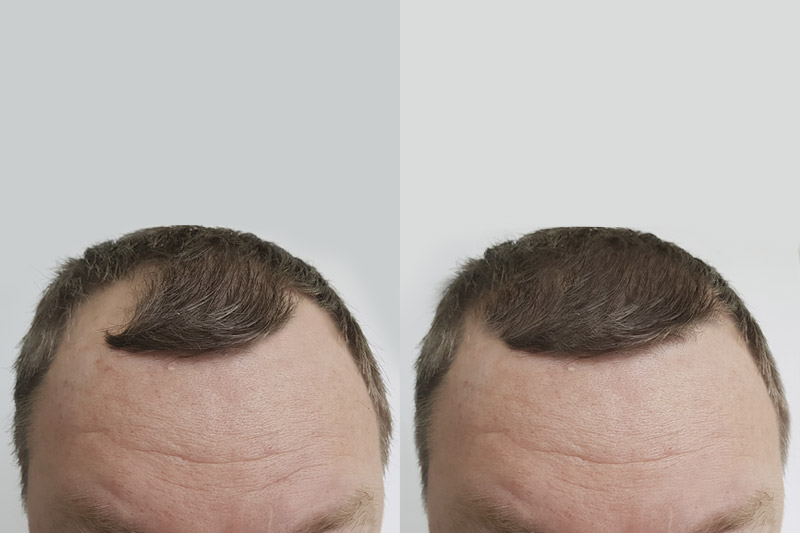Why would someone want to go through the hair transplantation process more than once? There are actually multiple reasons to have more than one hair transplant. Read on to review the three reasons why someone might seek another hair transplant.
1. Hair Transplant Surgery Does Not Stop the Progression of Male Pattern Hair Loss (MPHL) On Existing Hair
The hormone dihydrotestosterone (DHT) causes male pattern hair loss (MPHL). It attacks follicles predisposed to be vulnerable to this hormone, often located on the top of the scalp, causing miniaturisation and eventually hair loss. However, hair found elsewhere on the scalp, such as around the back and sides of the head, is usually resistant to this hormone. For this reason, the hair at the back and sides of the scalp is where donor grafts are taken from during FUE hair transplant surgery. Even when implanted into another part of the scalp, they remain invulnerable to DHT.
However, hair transplant surgery does not stop the progression of male pattern hair loss. The hair that is transplanted will not be lost, it will stay with the patient forever. But the rest of the hair may still thin and fall out. Top-up surgery will most likely be required. Many do not realise that when they decide to get a hair transplant, down the track they will likely need further hair transplants as it continues to thin in the front, mid central, and crown areas. The same is true regardless of hair transplant method (FUE, FUT/FUG).
2. Cost Can Be Spread Over Multiple Surgeries
Some patients decide to split treatments into two or three FUE implantation sessions, (from 6 to 12 months apart), to break up the cost of the procedure. If you’re on a limited budget, dividing your procedure can be helpful to your wallet but it can have an aesthetic benefit too. Multiple sessions also allow patients to gradually review the number of grafts needed from area to area in each visit – ensuring not too many or too little are implanted in a single treatment. This can be a great option for people who are wanting to keep their hair transplant on the down-low and not draw attention to an obvious hair transplant.
3. You May Wish to Implant Grafts/Follicles into Scarring from Previous FUG/FUT Transplants
While FUE is a much safer and less invasive treatment than FUG/FUT, many patients initially undergo this kind of surgery prior to engaging in FUE due to these treatments having a lower upfront cost. Melbourne Hair Transplant does not recommend FUG/FUT treatment due to the risk of scarring. Who would want a long linear scar across the back of the head? This can become particularly problematic in later years when patients are more likely to keep their hair shorter, and scars become more prominent.
The quality of FUE is a factor that our hair transplant surgeon encourages his patients to consider prior to engaging in any lower-cost surgeries like FUG or FUT. Ironically, despite the initial cost being lower for both these surgeries, patients often end up paying more for FUE to cover up errors caused by previous surgeries. This not only impacts the patient’s bank account, but also the pain endured by the patient for having to undergo additional surgery and downtime.
The difference between these two surgeries is in the method of the procedure. FUT/FUG involves the cutting of hair follicles from the back of the scalp in a long, thin strip-like fashion, from ear to ear, leaving the patient with a long linear scar, which is visible from behind. For this reason, it is sometimes known as “strip surgery”. In FUE hair transplantation, each follicular unit is individually extracted directly from the scalp, one at a time. No strip of tissue is removed. Because hair follicles in the FUE procedure are removed individually, the result is barely noticeable to the naked eye.
Key Takeaways
- Why might you have multiple hair transplant surgeries?
- Because of further hair loss. Hair transplant surgery does not stop the progression of male pattern hair loss (MPHL) on existing hair.
- They may wish to spread the cost of surgery over a longer period of time.
- To cover prominent scarring left behind by earlier FUT or FUG surgery. - Find out more about how hair transplant surgery could transform your hairline and book a consultation today.







